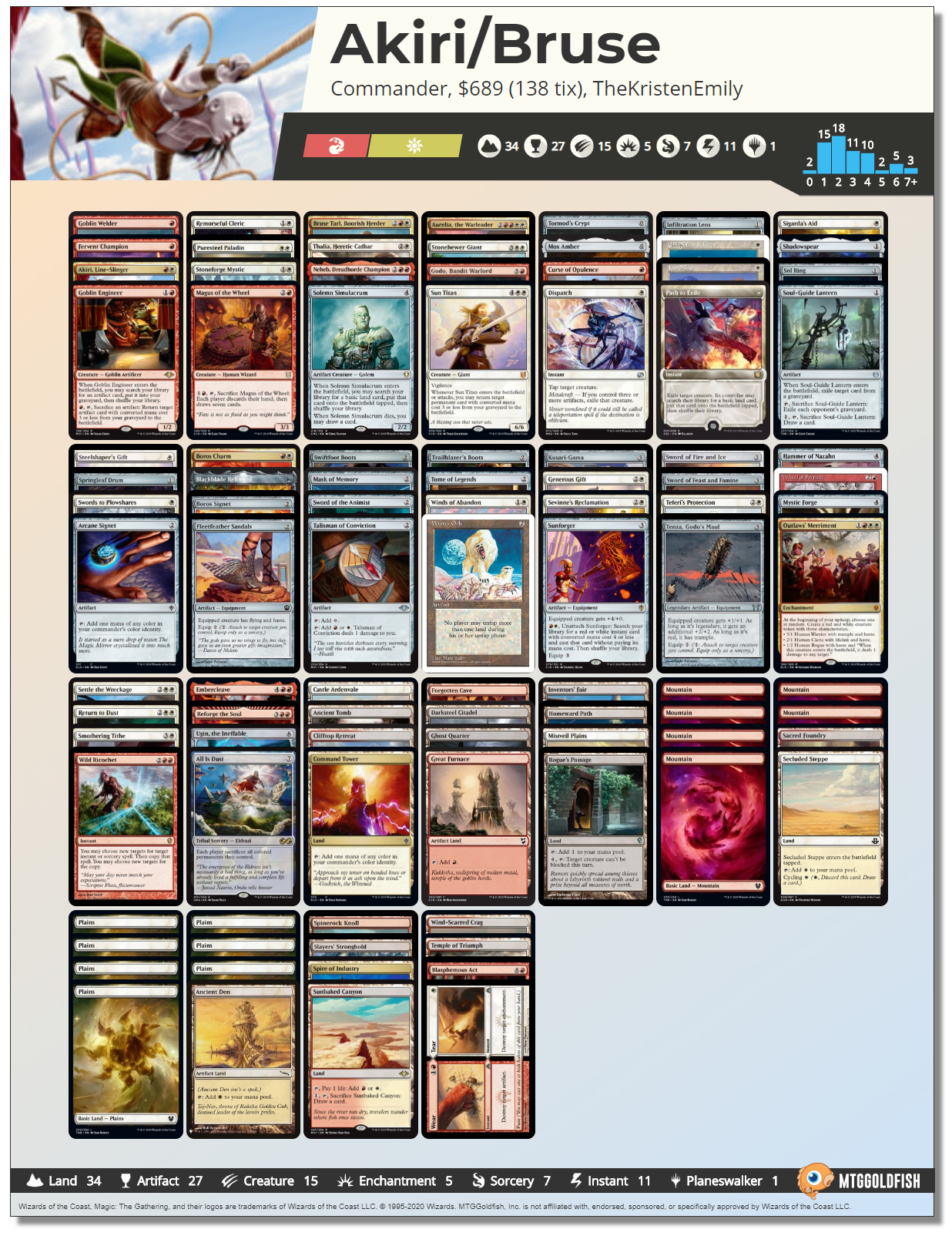Kristen shares an Akiri, Line-Slinger / Bruse Tarl, Boorish Herder Boros Voltron deck. There’s a time and a place for Winter Orb, and today, Kristen shares her ethos behind the more “chilling” side of Boros strategy.
Recently, you might have come across my article asking whether it was time to embrace land destruction in Commander. In it, I argued that due to the sheer amount of strong cards being printed for ramp strategies, like the recent The Great Henge and Nyxbloom Ancient, color combinations without access to that value were starting to fall further behind. This is made more frustrating by cards like Golos, Tireless Pilgrim. Between being able to grab Maze of Ith or Kor Haven as early as turn three, and the ability to clog the board with free blockers by playing Field of the Dead, the hurdles are really starting to stack up against more fair midrange combat-focused decks, and Voltron decks for that matter.
Whether you’re playing my favorite color combination Boros or not, you’ll likely have felt growing unease at the consistency that these decks can wield as they begin to disrupt your best laid plans, game after game. The issue is compounded by the amount of redundancy in the more ramping and controlling colors; for every one card like Smothering Tithe (which multicolor decks can abuse just as easily due to its splashability), Green, for example, is spoiled for choice. How many mana dorks do you play? Which ones? Do I cut Courser of Kruphix, Dryad of the Ilysian Grove, Oracle of Mul Daya, or Asuza, Lost but Seeking? This is true for card draw, too, and particularly when you start to enter the Simic or Sultai sphere, you’re not hurting for options.
Mardu, Orzhov, Rakdos, Boros, Jeskai, Grixis—all but the most degenerate strategies are starting to struggle with combating value, and your opponents likely know it. They’ll not pause to remove your inefficient card draw or ramp options, because they know you won’t recover by replacing them easily. And can you blame them? Wouldn’t you rather use your removal on something that matters too?
There are many lenses to look at this issue through, but today I’d like to look at it from the angle of playing a Voltron deck. Voltron has historically been a more fun and casual strategy that can be refined into something reasonably powerful at the 6-8 power range. But, due to the power creep we’re experiencing in Commander, many stronger Voltron decks that aimed for this power level are now starting to lag behind—they’ve not been gifted as many new toys that actually increase consistency, and so the inherent consistency in many decks that aim for this power level is actually resulting in more of a mismatch than ever before. I’d go as far as to say that if you aim to build a “value” deck at the 6-7 range, you’ll come out with an 8 a lot of the time due to the inherent synergy that Sultai cards in particular tend to enjoy. Other colors usually have to lean far more into synergy and deckbuilding restrictions to come anywhere close to that level, or sacrifice synergistic cards to play the limited ramp and draw options that don’t fit into their theme.
Closing a Game with Voltron
In order to close a game with Voltron, you need to plan effectively, and even then, a lot of things outside of your control need to go right. As much as I’ve said before that rolling dice for chip damage is a chumps game, it becomes a misplay with gravity when you care about damaging opponents out of the game before they can get a strong engine with board wipe or Cyclonic Rift back-up online.
Choosing your first focus point will generally come down to a number of important factors, factors that can change priority level based on the wider context of the game:
- Who will likely have chump blockers sooner?
- Who has a lifegain strategy?
- Which player is likely to combo off quickest?
- Who will likely have the most answers to your deck (e.g., heavy removal)?
- Which player can lock you out quickest—either through Maze of Ith effects or bounce wraths like Aetherize?
- Which player is likely to be the Archenemy?
The latter point is a little more nuanced than you’d think. It’s often better to soften up the other players by marking them with some early Commander damage before diverting your attention to the Archenemy when the threat becomes more apparent and you can put out more damage. Despite having a game plan, though, if your opponents draw removal heavy hands, or ramp quicker than you, or you draw particularly poorly; you’ll struggle to close the game.
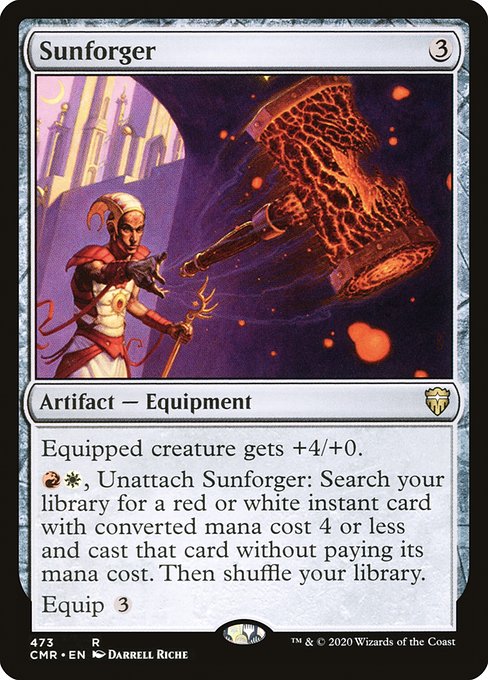
There are a number of tools currently available to buy you some time, and they’re auto-includes in most decks that can run them, with some of the others being strong considerations depending on your local metagame. You can stop people interfering with your board by responding with cards like Teferi’s Protection, Boros Charm, Rebuff the Wicked, or even Red Elemental Blast. Running a decent number of these effects can let you interact with the stack, something that’s actually pretty strong for a deck like this to do. Most control players won’t budget for having to interact on the stack with you, and will either tap out to the point they can’t, or simply not hold two spells to deal with you. Sunforger is the premier card for locking down this strategy, and once you’ve gotten some ramp and draw on the table (like Sword of the Animist and Tome of Legends), you’ll probably want to grab this next. It’s a great form of card advantage for colors that struggle for it, and it can become a reliable and repeatable tutor to dig you out of most situations.
The other way to keep gas in the tank is to run a recursion package. In most creature-based attacking decks, this is pretty easy to fit in, but in a Voltron build, can be harder to go all in on due to the need to dedicate so many slots to weapons/auras and ways to find them. Sun Titan is perhaps the most reliable include, and Sevinne’s Reclamation can punish players removing your early plays. Where possible, you should try to put your recursion on your few creatures or your weapons, like Sword of Light and Shadow.
As a Voltron deck like Akiri/Bruse lacks the free slots to go all in on recursion in the same way a deck like Aurelia, Angel Reanimator might, it can be weaker to blow outs and not ending the game quick enough on its own terms. Protecting your investments is then a higher priority, and that’s where a card like Winter Orb comes into play.
Winter Orb
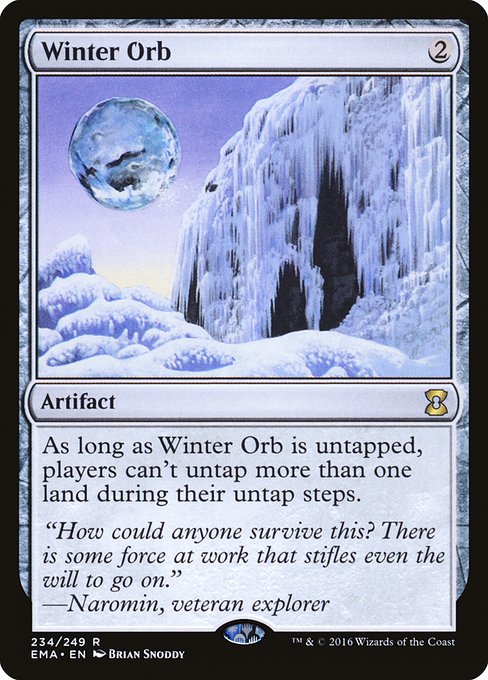
People play Winter Orb wrong all the time. Like most stax pieces, it’s only really correct to play it when you’re capable of winning within a few turns, or when you can break the symmetry. This is because you want to keep your friends, and not ruin the experience for everyone else. If this isn’t of concern to you, then feel free to just click away.
Cards like Winter Orb and also mass land destruction get a bad rap because people play them when they really shouldn’t. What I’d like to posit is that Winter Orb is closer in utility and potential to Boros Charm, or Teferi’s Protection, than it is to Static Orb or Stasis. That might be hard to wrap your head around on the first pass, but let me run you through it. Once you hit turns 6-7, most players have enough mana to both further their board and also take apart yours. If they’re not taking a turn off to deal with you, you’re losing that exchange; and what’s more, that’s when Cyclonic Rift mana is threatening your position. Decks with bountiful draw and ramp will always beat you in a longer game, and if they’ve parried some of your blows up until now, there’s a real danger that you can’t close the game.
Really, I don’t think a well-timed Winter Orb is any more oppressive than being able to recur counterspells or other interaction that grinds the game out, and nobody really has a problem with those. People play Collector Ouphe all the time, and it shuts off non-green ramp completely.
So, how can it be played correctly? Let’s look at a deck set up to do so.
Akiri, Line-Slinger & Bruse Tarl, Boorish Herder
Akiri & Bruse is a Voltron deck that aims to play cheap and impactful cards in the early game to reach a high velocity as quickly as possible. Most creatures and interaction are cheap, and so are the supporting artifacts that power up our Commander. Generally the aim is to strap up Akiri early on, and then use Bruse Tarl’s enter the battlefield effect to great effect, often times meaning a player needs to take only two to three hits to crumble under the sheer damage output available to us. Bruse for the most part is a combat trick in the Command Zone, a “signature spell” if you like. He can act as a good backup if Akiri is removed a few too many times, but we usually run him for his ability.
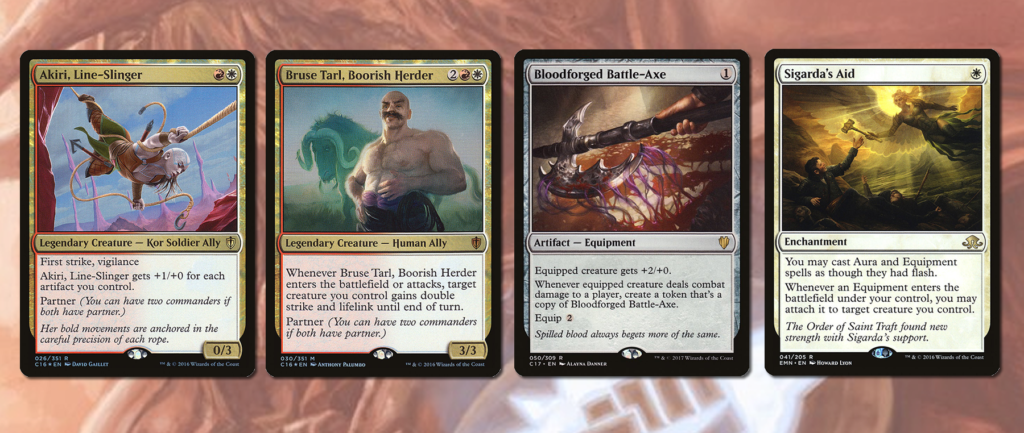
When you think of a Voltron deck, you usually think of a sizeable creature with evasion. Thankfully, though Akiri comes in as a 0/3, she gets bigger for each artifact you have in play, and can be granted evasion by any number of strong equipment like Trailblazer’s Boots, Fleetfeather Sandals, Embercleave, Shadowspear, and Tenza, Godo’s Maul. Both Sword of Feast and Famine and Sword of Fire and Ice also help her swing with impunity at the right opponents too, whilst conferring strong bonuses.
Card draw and ramp in the deck all need to be fairly low cost, and so we’re running cards like Mox Amber, Arcane Signet, Boros Signet, and Talisman of Conviction. Springleaf Drum allows us to capitalise on our utility creatures or just Akiri having Vigilance. We have some cheap draw in the form of Tome of Legends (an excellent option for Partner decks), Mask of Memory, Infiltration Lens, and Sword of Fire and Ice. This is augmented by the tried and tested Wheel of Fortune or Reforge the Soul plus Smothering Tithe combination; and equipment tutors like Stoneforge Mystic, Steelshaper’s Gift, and Godo, Bandit Warlord.
As we’re running a Voltron build, the few creatures we do have are quite focused; Sun Titan for repeatable recursion, Aurelia, the Warleader for extra equipment triggers, and Remorseful Cleric for cheap graveyard interaction that wears equipment well.
Power Plays
Winter Orb is a great way to close a game with this deck. We can make sure the effect is asymmetrical by either jamming lots of mana rocks and treasure production like Curse of Opulence and Smothering Tithe, by using Sword of Feast & Famine to untap our lands, or by simply welding the Orb in and out of play so that we can untap and our opponents cannot. This works most reliably with both Goblin Welder and Goblin Engineer in play, or Aurelia for double untap triggers. Welder and Engineer are both great cards in their own right too, offering us some much needed ways to buy back equipment, and Aurelia is everything the deck wants to be doing.
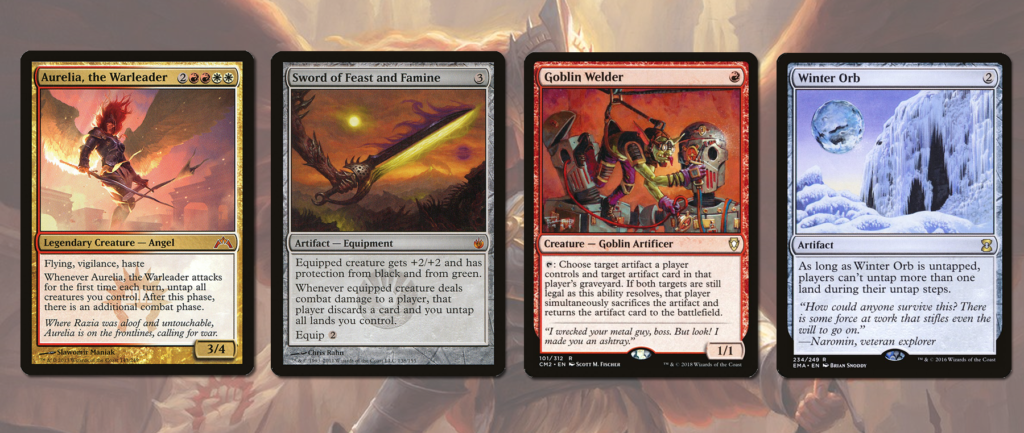
Outlaws’ Merriment is a new card I’m trying from Throne of Eldraine. The idea is that when you’ve suitably locked the table down with Winter Orb, getting free tokens every turn is an incredible amount of value, particularly if they have haste and sometimes trample. Outside of this, though, it lets us push damage through and not care about removal, keeping Akiri safe in the Command Zone until we need her. Also from this expansion is Fervent Champion. This is a card that might look a little weak at first, but hides a lot of potential. Equipping this guy with Sword of the Animist and swinging as early as turn 2 is incredible; beyond that, having a free equip for Sunforger can go a long way to making you resilient and hard to deal with. Wild Ricochet is a favorite in my Sunforger package, and can lead to some big blow outs.
We play all of the most efficient removal to augment our plan. Dispatch joins Swords to Plowshares and Path to Exile; for wraths we play Blasphemous Act and All is Dust for the sheer value. We can often give our creatures protection from Red or indestructible, and wiping the board except for our mana rocks and equipment is an equally strong play. We also play Winds of Abandon and Settle the Wreckage, two slightly riskier wraths that our deck is happy to play a little loose with—our potency and potential for removing players if we’re free to attack means we won’t care about ramping our opponents if they’re going to die anyways.
Mystic Forge can do a lot of work for us, particular with many of our artifacts costing little to cast. Ripping Mox Amber and Tormod’s Crypt off the top feels great; in combination with the powerhouse Ugin, the Ineffable, we can churn through our library and play more cards than anyone has a right to do. We’ll be thankful for the free equip cost granted by Puresteel Paladin at times like this, and the ability to turn those equipment off the top into card draw means we can potentially draw past the cards we can’t cast that are inbetween. Don’t forget that you can always exile a card using Mystic Forge while the trigger to draw is on the stack.
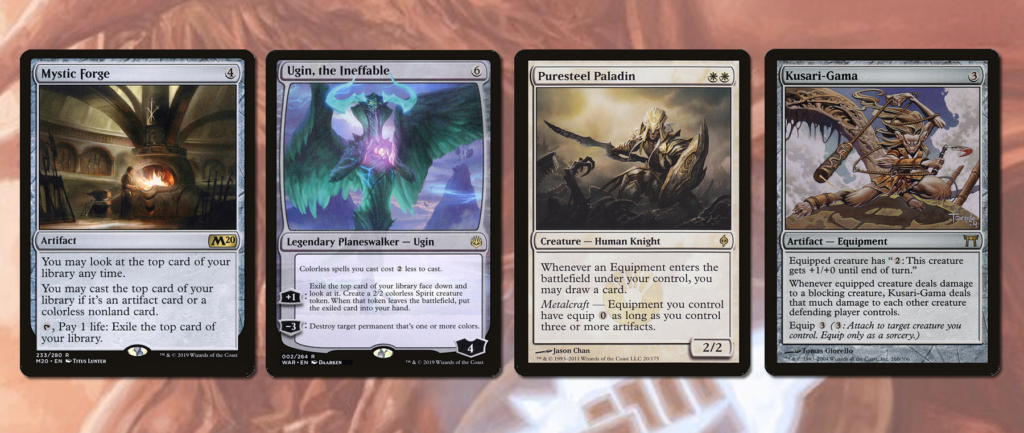
Finally, I’d like to highlight how we can give our opponents a “deal with the devil” through cards like Infiltration Lens and Kusari-Gama. Taking Commander damage is something they really won’t want to do, so if we can get something out of them blocking, then why wouldn’t we? Infiltration Lens draw us two cards when Akiri becomes blocked; and Kusari-Gama, more than just letting us “firebreathe,” can actually wipe an opponent’s board. I guarantee they’ll have to read this one multiple times!
In Conclusion
Playing “fairer” Magic has become increasingly difficult as the game experiences a shift in power creep. Whilst most of the new cards are deemed fair to play (because it’s only natural, right?), there’s still a heavy stigma around some of the way decks can deal with the imbalance in power. I’m not going to advocate for playing full stax, and I never will—nor will I really be happy to lean into mass land destruction, as I said in my article previously—but honestly? Something’s got to give. For “fairer” midrange or aggro decks to remain competitive when they aren’t playing within the Simic and Sultai sphere, I think Winter Orb is a completely fair card.
Just make sure to play it to close a game so y’all can go grab ice cream—giving your opponents brain freeze as soon as they sit down is never a good idea.
Based in the UK, Kristen is a lover of both Limited and Commander, and can most often be found championing the Boros Legion when called upon to sit down and shuffle up.


